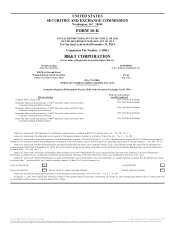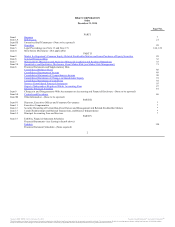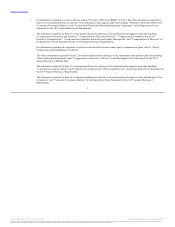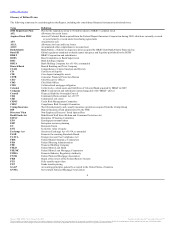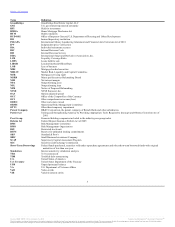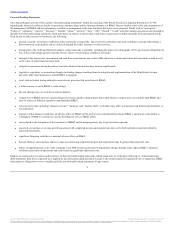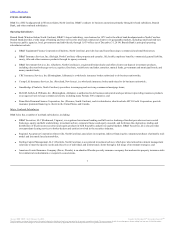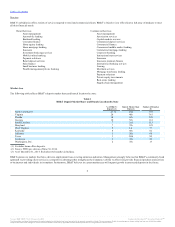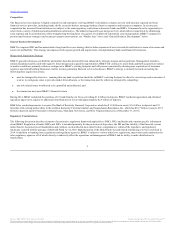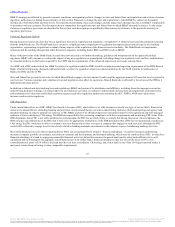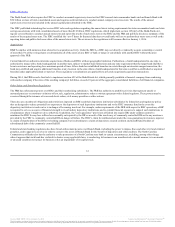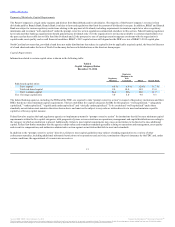BB&T 2014 Annual Report Download - page 10
Download and view the complete annual report
Please find page 10 of the 2014 BB&T annual report below. You can navigate through the pages in the report by either clicking on the pages listed below, or by using the keyword search tool below to find specific information within the annual report.
Table of Contents
Competition
The financial services industry is highly competitive and constantly evolving. BB&T’s subsidiaries compete actively with national, regional and local
financial services providers, including banks, thrifts, securities dealers, mortgage bankers, finance companies and insurance companies. In recent years,
competition has increased from institutions not subject to the same regulatory restrictions as domestic banks and BHCs. Consumers have the opportunity to
select from a variety of traditional and nontraditional alternatives. The industry frequently sees merger activity, which affects competition by eliminating
some regional and local institutions, while strengthening the franchises of acquirers. For additional information concerning markets, BB&T’s competitive
position and business strategies and recent government interventions, see “Market Area” above and “General Business Development” below.
General Business Development
BB&T is a regional FHC and has maintained a long-term focus on a strategy that includes expansion of asset size and diversification in terms of revenues and
sources of profitability. This strategy encompasses both organic growth and acquisitions of complementary banks and financial businesses.
Merger and Acquisition Strategy
BB&T’s growth in business, profitability and market share has historically been enhanced by strategic mergers and acquisitions. Management intends to
remain disciplined and focused with regard to future merger and acquisition opportunities. BB&T will continue to assess bank and thrift acquisitions subject
to market conditions, primarily within or contiguous to BB&T’s existing footprint, and will pursue economically advantageous acquisitions of insurance
agencies, specialized lending businesses, and fee income generating financial services businesses. BB&T’s strategy is currently focused on meeting the
following three acquisition criteria:
·must be strategically attractive – meaning that any bank acquisition should be in BB&T’s existing footprint to allow for cost savings and economies of
scale or in contiguous states to provide market diversification, or the transaction must be otherwise strategically compelling;
·any risk-related issues would need to be quantified and addressed; and
·the transaction must meet BB&T’s financial criteria.
During 2014, BB&T completed the purchase of 21 bank branches in Texas, providing $1.2 billion in deposits. BB&T reached an agreement and obtained
regulatory approval to acquire 41 additional retail branches in Texas with approximately $2.3 billion in deposits.
BB&T also reached agreements to acquire The Bank of Kentucky Financial Corporation, which has $1.9 billion in assets, $1.6 billion in deposits and 32
branches with a strong market share in the northern Kentucky/Cincinnati market, and Susquehanna Bancshares, Inc., which has $18.7 billion in assets, $13.7
billion in deposits and 245 branches in Pennsylvania, Maryland, New Jersey, and West Virginia (balances as of December 31, 2014).
Regulatory Considerations
The following discussion describes elements of an extensive regulatory framework applicable to BHCs, FHCs and banks and contains specific information
about BB&T. Regulation of banks, BHCs and FHCs is intended primarily for the protection of depositors, the DIF and the stability of the financial system,
rather than for the protection of shareholders and creditors. As described in more detail below, comprehensive reform of the legislative and regulatory
landscape occurred with the passage of the Dodd-Frank Act in 2010. Implementation of the Dodd-Frank Act and related rulemaking activities continued in
2014. In addition to banking laws, regulations and regulatory agencies, BB&T is subject to various other laws, regulations, supervision and examination by
other regulatory agencies, all of which directly or indirectly affect the operations and management of BB&T and its ability to make distributions to
shareholders.
9
Source: BB&T CORP, 10-K, February 25, 2015 Powered by Morningstar® Document Research℠
The information contained herein may not be copied, adapted or distributed and is not warranted to be accurate, complete or timely. The user assumes all risks for any damages or losses arising from any use of this information,
except to the extent such damages or losses cannot be limited or excluded by applicable law. Past financial performance is no guarantee of future results.


